Mansoura Veterinary Medical Journal
Document Type
Original Article
Keywords
Biogenic-SeNPs, Microalga, Characterization, Efficacy.
Abstract
Background Selenium nanoparticles (SeNPs) were synthesized using a green method with Pediastrum boryanum extract as the reducing and capping agent. Objectives The algal extract and green synthesized SeNPs were characterized for their morphological characters and biological efficacy. Methods Characterization was conducted using UV-vis spectroscopy, Fourier transform infrared spectroscopy (FTIR), transmission electron microscopy (TEM), and zeta potential analysis. Results TEM revealed spherical and tetragonal SeNPs with sizes ranging from 72.16-89.45 nm. FTIR spectroscopy confirmed the presence of functional groups from the algal extract on the SeNPs surfaces, indicating their role as capping agents. Phytochemical analysis showed that the extract had higher total phenolics (51.114 mg GAE/g) and flavonoids (19.225 mg QE/g) than SeNPs (27.154 and 9.931 mg/g, respectively). The extract also exhibited greater antioxidant activity than SeNPs in the 1,1-Diphenyl-2-picrylhydrazyl (DPPH) radical scavenging assay. Evaluation of antimicrobial effects against fish pathogens demonstrated broad-spectrum inhibitory activity for the algal extract against Aeromonas veronii, A. sobria, Streptococcus iniae, Edwardsiella ictaluri, and A. hydrophila (MIC 64-256 μg/mL). A brine shrimp lethality assay (BSLA) revealed potent dose-dependent cytotoxicity of both the extract (LC50 51.56 μg/mL) and SeNPs (LC50 11.88 μg/mL). Overall, this green synthesis method successfully produced stable SeNPs with enhanced bioactivities. Conclusions These results highlight the potential of the microalga P. boryanum as a sustainable nano-factory for the green synthesis of SeNPs with significant bioactive effects that warrant further pharmacological investigation.
How to Cite This Article
Al-Wakeel, Ahmed H; Elbahnaswy, Samia; El‐Moaty, Amany Abd; El-Ghamry, Ayman M.; El-Khateeb, Ayman Y.; Risha, Engy; and Zahran, Eman
(2024)
"Green synthesis and characterization of SeNPs using Pediastrum boryanum extract and evaluation of their biological activities,"
Mansoura Veterinary Medical Journal: Vol. 25:
Iss.
1, Article 1.
DOI: https://doi.org/10.35943/2682-2512.1229
Receive Date
Feb 7, 2024
Accept Date
Feb 18, 2024
Publication Date
2024






